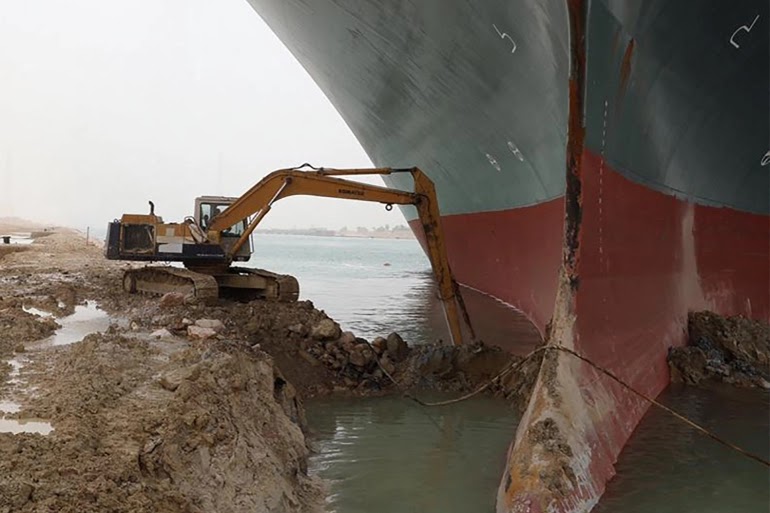UNUSUAL HISTORY: The Suez Canal and the Yellow Fleet
 |
| Attempts to free the Ever Given, March 2021 |
The blocking of the Suez Canal by the running aground of the freighter Ever Given has brought much attention to the importance of the Suez Canal as an international shipping lane. News reports have noted that the other route – around Africa via the Cape of Good Hope – contains added risks of severe weather and piracy. This is not the first time that the operations of the Suez Canal have been halted – and past incidents include the unusual story of what became known as the Yellow Fleet.
The 1967
Arab-Israeli War, sometimes referred to as the Six Day War, led to Egypt blocking
both ends of the canal. Debris, sunken
ships, and explosives trapped ships from the UK, the USA, France, West Germany,
Sweden, Poland, Bulgaria, and Czechoslovakia.
Caught in the desert winds, sand soon began to cover the ships, clinging
to the metal, turning the ships to a dusty shade of yellow and giving the ships
were colloquial name – the Yellow Fleet.
The fourteen ships which would remain stranded in the canal were far fewer
than the estimated three hundred ships currently forming a maritime traffic jam
in the Middle East today, but they have so far been there for a far shorter
amount of time. Far from being able to
leave at the end of the 1967 war, the ships of the Yellow Fleet would be stranded
there for a total of 8 years. It was
only in the aftermath of the 1973 Arab Israeli War (also called the Yom Kippur War,
Ramadan War, or October War) that the canal was reopened.
 |
| The Yellow Fleet, 1967 |
The blocking of
the canal to all shipping sprang from a strategy by the Egyptian government to
deny the canal to Israeli shipping – since they could not keep it open and exclude
Israeli traffic the decision was taken to seal both ends of the canal. In reality the financial cost of running the
canal would have been too much for the Egyptian government – since few companies
would risk sending freight through a no mans land of a bitter war. This left the fourteen of the fifteen ships
that had been heading north trapped in the canal. This in turn led to the forming of the Great
Bitter Lake Association (which took its name
from the area of the canal in which the ships were anchored – the widest
portion of the canal itself). It was a
mutual support agreement between the officers and crew of the ships. The Association even organised the ‘Bitter
Lake Olympic Games’ to run at the time of the 1968 Summer Olympics. The Association even implemented its own
postal service producing handcrafted stamps which were recognised by the
Egyptian postal service. These stamps
are now highly sort after by private collectors.
Over time the shipping companies were able to reduce the number of crew on each
vessel, who rotated every three months, until care of the ships was handed to a
Norwegian company in 1972. In 1975 the
ships were finally freed. Only two of
the fourteen were able to make it to their destinations under their own power
after years exposed in the canal. The longest
journey was the Munsterland whose voyage to Australia had finally taken a
total of eight years, three months, and five days. The story of the Yellow Fleet was revisited around 2015 with the publication of two books on the subject in a short space of time.
Both the blocking of the Canal by the Ever Given and the incident of the Yellow Fleet serve to highlight the importance of the Suez canal, and how much international trade relies on these vast freighters travelling along long established sea routes.


